24 – 29 OCTOBER 2024
By Chris Lotz
Overview
This was a spectacular and successful birding tour of Tasmania. We enjoyed great views of both Critically Endangered Tasmanian breeding endemic parrots (Orange-bellied and Swift Parrots), all the Tasmanian endemic birds except for Tasmanian Boobook, but including the Endangered Forty-spotted Pardalote, a number of species which are relatively easy to find in Tasmania, such as Pink Robin, Crescent Honeyeater, Southern Emu-wren, Beautiful Firetail, Hooded Plover (Dotterel), and great mammals, such as the weird Tasmanian form of Short-beaked Echidna (an egg-laying mammal!), beautifully spotted Eastern Quoll, a lot of Red-necked Wallabies (the Tasmanian endemic subspecies, known as Bennett’s Wallaby) and various others.
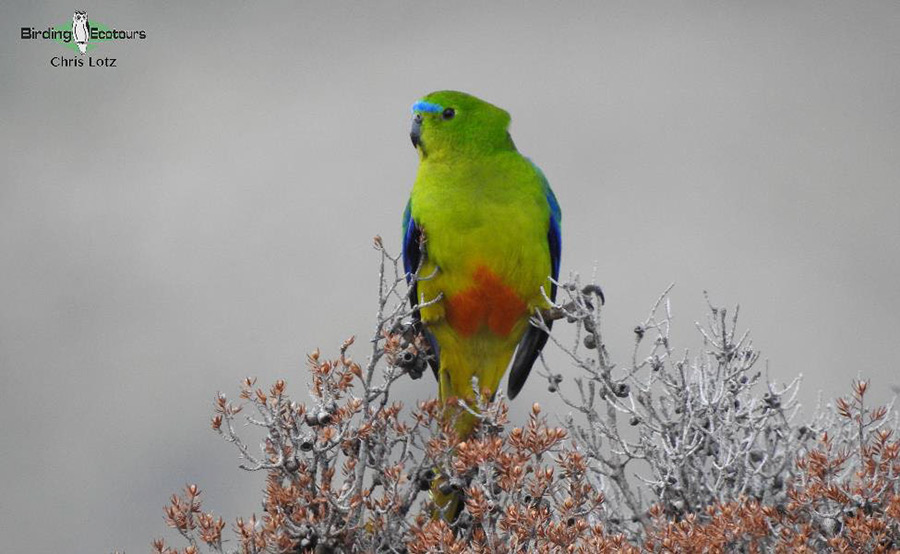
Orange-bellied Parrot showed well at Melaleuca.
Tasmania is a stunningly beautiful island, and we thoroughly enjoyed spectacular views during our scenic charter flight to remote Melaleuca (we include this for Orange-bellied Parrot), as well as fabulous views and idyllic surroundings on the wildlife paradise that is Bruny Island.
Detailed Report
Day 1, 24th October 2024. Arrival in Hobart
Everyone arrived today and the tour officially started with a 6 pm welcome dinner.
Day 2, 25th October 2024. Orange-bellied Parrots at Melaleuca
Today we took a wonderfully scenic charter flight to Melaleuca in the remote and beautiful southwestern corner of Tasmania. We enjoyed stunning scenery over Bruny Island and the south coast of Tasmania, as we hugged the coast en route to Melaleuca. On our return flight at the end of the day, we took a different (inland) route back to Hobart, enjoying gorgeous views of snow-capped mountains.
The main target around Melaleuca was the Critically Endangered (BirdLife International) Orange-bellied Parrot. This is the only site on the planet where this species breeds, and there are thought to be fewer than 30 adults left, and an outbreak of Psittacine Beak and Feather Disease in 2014 didn’t help the dire status of this species. We saw almost a third of the world population of these beautiful little parrots today. Here at Melaleuca, we also enjoyed seeing many Green Rosellas, a Tasmanian endemic, and we heard (Eastern) Ground Parrot. Yellow-throated Honeyeaters (also endemic), Southern Emu-wren, several close-up Striated Fieldwrens, a gorgeous Beautiful Firetail, and a couple of demure (but endemic!) Dusky Robins were all very popular birds with our group.
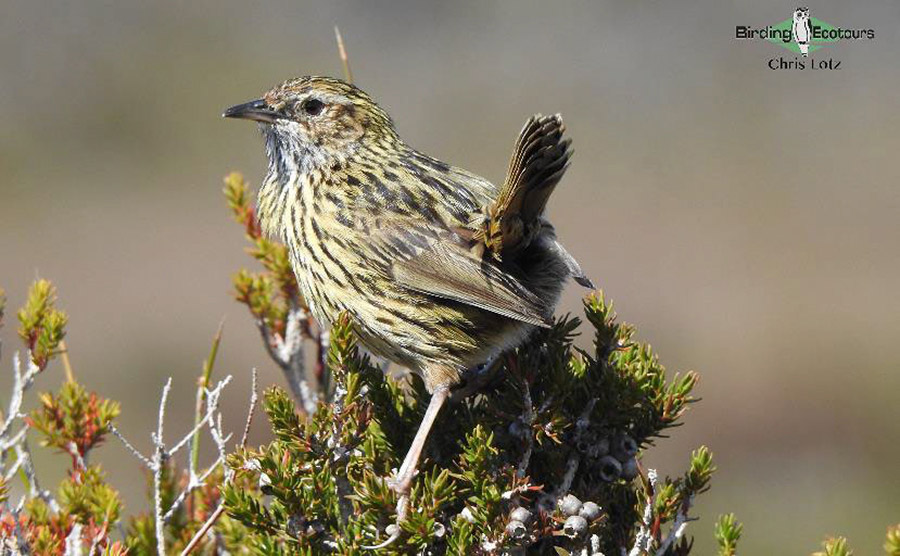
Striated Fieldwren showed nicely.
Out on the lagoon were Black Swans, a Little Black Cormorant and a couple of Little Pied Cormorants. These are common Australian birds, but all were new species for the tour participants.
After our charter flight touched down back in Hobart this afternoon, we continued looking around for birds. Notably, we increased our parrot count for the day up to eight species. These came in a wide variety of forms: attractive Eastern Rosellas, close up Musk Lorikeets showing really well feeding on Eucalyptus nectar (along with Noisy Miners), wonderfully pink Galahs, a Sulphur-crested Cockatoo,and a Little Corella. There were also many other great birds around Hobart. These included stacks of Tasmanian Nativehens, many of them with young chicks. (This is an entertaining, flightless Tasmanian endemic.) We also found some Maned and Pacific Black Ducks and a Hoary-headed Grebe. A Swamp Harrier flew over. There were stacks of Masked Lapwings, Kelp Gulls and Silver Gulls around. Australian Magpies, Grey Currawongs and Forest Ravens also put in appearances.
We also enjoyed seeing a great mammal, Southern Brown Bandicoot, during our late afternoon Hobart session.
All in all, this was a brilliant first full day on the picturesque island of Tasmania!
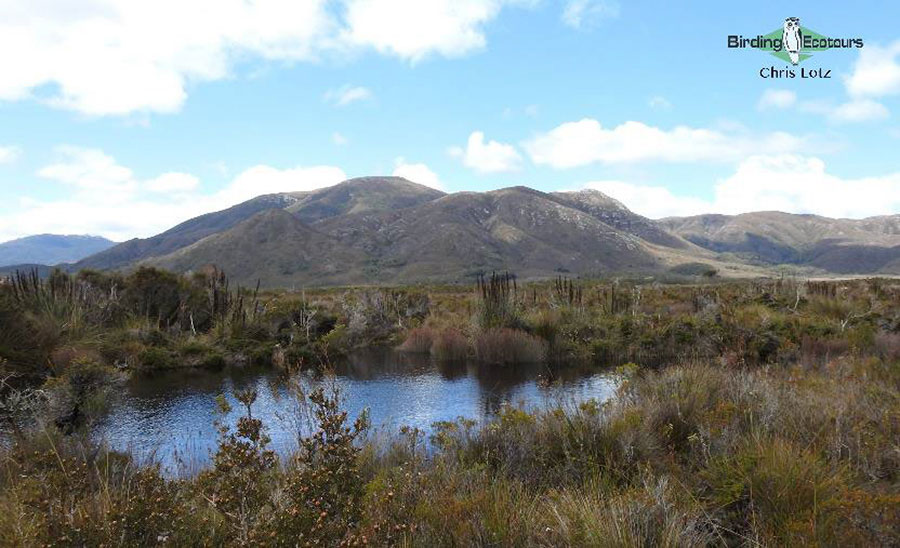
Melaleuca scenery.
Day 3, 26th October 2024. Birding Mount Nelson, Fern Glade, the Waterworks Reserve and Pipe Clay Lagoon
After breakfast, we headed to Mount Nelson to try and find Critically Endangered Swift Parrots and we were not disappointed! We enjoyed seeing about a dozen of these rare Tasmanian breeding endemics mingling with other parrots. Swift Parrots are declining rapidly due to nest predation by introduced Sugar Gliders.
We found a lot of other great birds around Mount Nelson. We found our first of many Superb Fairywrens (these are dazzling, confiding birds that have to be seen to be believed). We also saw several new honeyeaters in the form of Eastern Spinebill, New Holland Honeyeater, Little Wattlebird, the Tasmanian endemic giant honeyeater species Yellow Wattlebird, and a few of another endemic honeyeater, Black-headed Honeyeater.
There were many Striated Pardalotes around, as well as some Brown Thornbills, a Black-faced Cuckooshrike, Grey Currawongs, and huge-billed Tasmanian endemic Black Currawongs. A beautiful male Scarlet Robin was one of the highlights in this area.
Our next birding site for the morning was Fern Glade, on the forested slope of Mount Wellington. Here, we enjoyed great views of a Shining Bronze Cuckoo on the edge of the forest from the parking lot. As we started walking the forest trail, we found good numbers of Tasmanian Scrubwrens and Tasmanian Thornbills, both endemics. Another Tasmanian endemic, Scrubtit, proved far trickier but we eventually got superb views of one. Olive Whistlers and a female Pink Robin were also good to see.
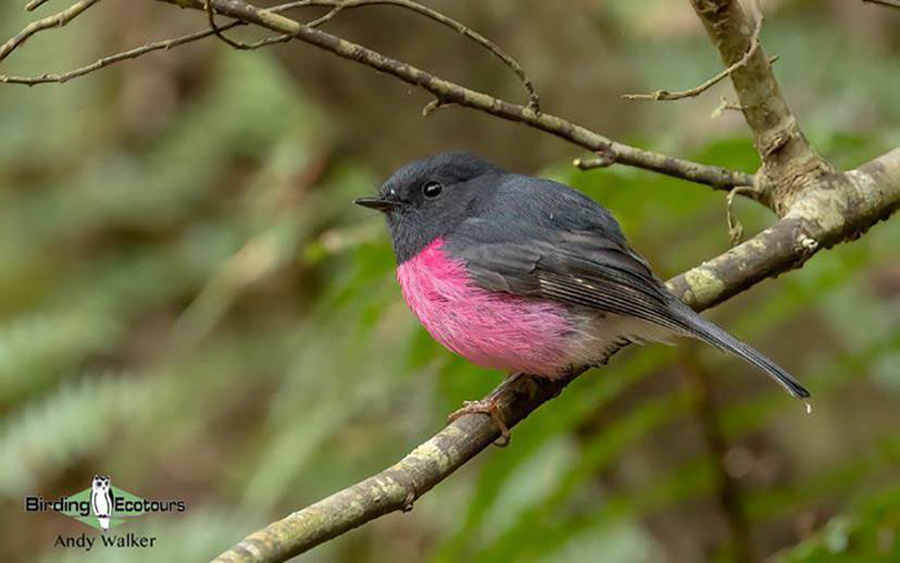
We had to wait until later in the tour to see a male Pink Robin, but we were too busy admiring it to photograph it, so this is Andy Walker’s photo from a previous year’s tour
After a delicious lunch at a nearby pub, we headed for the famous (among birders) Waterworks Reserve. There were several duck species here, including Hardhead which was new for the tour. A Laughing Kookaburra and a Brown Goshawk put in brief appearances. During the relatively warm hours of the day, the reserve was unusually quiet, so we decided to move to an area with coastal lagoons near Cremorne.
The Cremorne/Pipe Clay Lagoon area proved very productive. We found some new waterfowl species in the form of beautiful Australian Shelducks, a very co-operative male Musk Duck (such a bizarre species!) and a Chestnut Teal. Black-faced Cormorants showed well, as did massive-billed Pacific Gulls. A White-bellied Sea Eagle, a couple of Swamp Harriers, and a brief Brown Falcon were welcome additions to our raptor list. We enjoyed seeing some new shorebirds for the trip: four Bar-tailed Godwits, two Red-necked Stints, about a dozen Red-capped Plovers, large numbers of Pied Oystercatchers, and two Sooty Oystercatchers.
An Australian Pipit and a White-fronted Chat showed distantly.
All in all, this was another super-amazing day, but spectacular Bruny Island was calling our names, the next exciting stint on our agenda.
Day 4, 27th October 2024. Bruny Island
We caught the 7.10 am ferry onto Bruny Island and immediately headed to our Forty-spotted Pardalote site, finding a couple of them after exercising a bit of patience. This is an Endangered (BirdLife International) species with a tiny range, occurring in only three small parts of Tasmania. The supporting cast here included a few beautiful Blue-winged Parrots, a couple of Pallid Cuckoos, several close-up Yellow-rumped Thornbills and a large number of New Holland and Black-headed Honeyeaters.
Continuing further onto Bruny Island, we briefly saw a majestic pair of humongous Wedge-tailed Eagles soaring. Soon afterwards, we got more prolonged views of a White-bellied Sea Eagle.A Grey Butcherbird and a Laughing Kookaburra were next on the birding menu.
Two Tree Point was rewarding, with a Hooded Plover (Dotterel),showing really well, some Pacific Gulls with their massive bills dwarfing the nearby Silver Gulls, an Australasian Gannet that almost flew over us, a Shy Albatross majestically gliding low over the water in the distance, and a number of Strong-billed Honeyeaters, yet another Tasmanian endemic. Superb Fairywrens were everywhere, here and at virtually all other places we visited today. They are such confiding, showy, spectacular birds.
After a delicious lunch, we birded the Adventure Bay area, which proved great for some spectacular robins. We enjoyed close views of a pair of Scarlet Robins and two separate Flame Robins, one a luminously colorful male. We also got great views of Chestnut Teals and a number of other birds around this area.
On the way to our accommodation for the night, we located a Fan-tailed Cuckoo.We checked into our accommodation around 4 pm and heard a Tawny Frogmouth and saw a beautiful Australian Golden Whistler.
After a tasty dinner, we went to The Neck Rookery to observe huge numbers of Short-tailed Shearwaters coming in to roost. On our way there, we saw loads of Red-necked (Bennett’s) Wallabies, some carrying joeys in their pouches.Driving back to the accommodation after dark, we were pleased to see some great mammals. Rufous-bellied (Tasmanian) Pademelons, beautifully spotted Eastern Quolls and a Common Ringtail Possum were highlights.
Day 5, 28th October 2024. Another morning on Bruny Island, and an afternoon back on the “mainland”
The first bird we wanted to target was a male Pink Robin as, to date, we had only seen the female. After some searching, we eventually found one at Clennetts Top Mill Site, and got superb views.
We then went to the Cape Bruny lighthouse. The scenery here was gorgeous. It was, however, excessively windy, making birding challenging. We did see our first Short-beaked Echidna; the Tasmanian endemic subspecies is very different from the mainland form, and a bizarre animal.
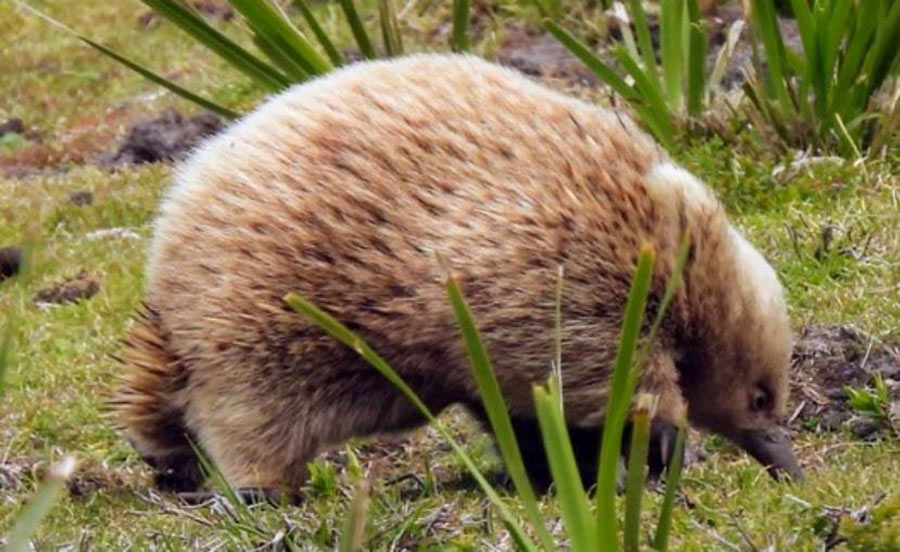
Short-beaked Echidna (photo by tour participant Elizabeth Bailey).
Despite the wind, we did enjoy seeing some other good birds from the lighthouse, including Peregrine Falcon, White-bellied Sea Eagle, Flame Robin, Scarlet Robin and countless New Holland Honeyeaters.
It was time to leave wonderful Bruny Island, but we made some birding stops en route to the ferry. We spent a little time birding around The Neck Campground, where we got good views of Olive Whistler and several other good birds we’d seen previously. At McCrackens Gully, we enjoyed an amazing view of a magnificent Wedge-tailed Eagle, several Australasian Grebes and various others. While waiting for the ferry, we got an excellent view of a White-bellied Sea Eagle, and some Black-faced Cormorants, amongst others. We checked into our Hobart hotel early enough for a bit of a rest before dinner.
Day 6, 29th October 2024. Final Tasmania birding
After breakfast, we headed to the Margate area to try and locate Crescent Honeyeater. After some patience, we eventually managed to get good views of one. We then headed to a nearby site where we added Spotted Pardalote to our list. We saw a lot of other bird species this morning, although the above two were the only new trip birds. We then headed to the airport to fly to Melbourne in preparation for our eastern Australia birding tour.
Bird List – Following IOC (version 14.2, August 2024)
Birds ‘heard only’ are marked with (H) after the common name, all other species were seen. The following notation after species names is used to show conservation status following BirdLife International: CR = Critically Endangered, EN = Endangered, VU = Vulnerable.
| Common name | Scientific name |
| Ducks, Geese, Swans (Anatidae) | |
| Black Swan | Cygnus atratus |
| Australian Shelduck | Tadorna tadornoides |
| Maned Duck | Chenonetta jubata |
| Pacific Black Duck | Anas superciliosa |
| Mallard | Anas platyrhynchos |
| Chestnut Teal | Anas castanea |
| Musk Duck | Biziura lobata |
| Frogmouths (Podargidae) | |
| Tawny Frogmouth (H) | Podargus strigoides |
| Cuckoos (Cuculidae) | |
| Shining Bronze Cuckoo | Chalcites lucidus |
| Pallid Cuckoo | Heteroscenes pallidus |
| Fan-tailed Cuckoo | Cacomantis flabelliformis |
| Pigeons, Doves (Columbidae) | |
| Rock Dove | Columba livia |
| Spotted Dove | Spilopelia chinensis |
| Rails, Crakes & Coots (Rallidae) | |
| Tasmanian Nativehen (Endemic) | Tribonyx mortierii |
| Eurasian Coot | Fulica atra |
| Grebes (Podicipedidae) | |
| Australasian Grebe | Tachybaptus novaehollandiae |
| Hoary-headed Grebe | Poliocephalus poliocephalus |
| Great Crested Grebe | Podiceps cristatus |
| Oystercatchers (Haematopodidae) | |
| Pied Oystercatcher | Haematopus longirostris |
| Sooty Oystercatcher | Haematopus fuliginosus |
| Plovers (Charadriidae) | |
| Hooded Plover – VU | Charadrius cucullatus |
| Masked Lapwing | Vanellus miles |
| Red-capped Plover | Anarhynchus ruficapillus |
| Sandpipers, Snipes (Scolopacidae) | |
| Bar-tailed Godwit | Limosa lapponica |
| Red-necked Stint | Calidris ruficollis |
| Gulls, Terns, Skimmers (Laridae) | |
| Silver Gull | Chroicocephalus novaehollandiae |
| Pacific Gull | Larus pacificus |
| Kelp Gull | Larus dominicanus |
| Albatrosses (Diomedeidae) | |
| Shy Albatross | Thalassarche cauta |
| Petrels, Shearwaters, Diving Petrels (Procellariidae) | |
| Short-tailed Shearwater | Ardenna tenuirostris |
| Gannets, Boobies (Sulidae) | |
| Australasian Gannet | Morus serrator |
| Cormorants, Shags (Phalacrocoracidae) | |
| Little Pied Cormorant | Microcarbo melanoleucos |
| Black-faced Cormorant | Phalacrocorax fuscescens |
| Little Black Cormorant | Phalacrocorax sulcirostris |
| Great Cormorant | Phalacrocorax carbo |
| Herons, Bitterns (Ardeidae) | |
| White-faced Heron | Egretta novaehollandiae |
| Kites, Hawks, Eagles (Accipitridae) | |
| Wedge-tailed Eagle | Aquila audax |
| Brown Goshawk | Tachyspiza fasciata |
| Collared Sparrowhawk | Tachyspiza cirrocephala |
| Swamp Harrier | Circus approximans |
| White-bellied Sea Eagle | Icthyophaga leucogaster |
| Kingfishers (Alcedinidae) | |
| Laughing Kookaburra | Dacelo novaeguineae |
| Caracaras, Falcons (Falconidae) | |
| Australian Hobby | Falco longipennis |
| Brown Falcon | Falco berigora |
| Peregrine Falcon | Falco peregrinus |
| Cockatoos (Cacatuidae) | |
| Galah | Eolophus roseicapilla |
| Little Corella | Cacatua sanguinea |
| Sulphur-crested Cockatoo | Cacatua galerita |
| Old World Parrots (Psittaculidae) | |
| Green Rosella (Endemic) | Platycercus caledonicus |
| Eastern Rosella | Platycercus eximius |
| Swift Parrot – CR | Lathamus discolor |
| Ground Parrot (H) | Pezoporus wallicus |
| Blue-winged Parrot – VU | Neophema chrysostoma |
| Orange-bellied Parrot – CR | Neophema chrysogaster |
| Musk Lorikeet | Glossopsitta concinna |
| Australasian Wrens (Maluridae) | |
| Superb Fairywren | Malurus cyaneus |
| Southern Emu-wren | Stipiturus malachurus |
| Honeyeaters (Meliphagidae) | |
| Eastern Spinebill | Acanthorhynchus tenuirostris |
| White-fronted Chat | Epthianura albifrons |
| Crescent Honeyeater | Phylidonyris pyrrhopterus |
| New Holland Honeyeater | Phylidonyris novaehollandiae |
| Yellow-throated Honeyeater (Endemic) | Nesoptilotis flavicollis |
| Strong-billed Honeyeater (Endemic) – VU | Melithreptus validirostris |
| Black-headed Honeyeater (Endemic) | Melithreptus affinis |
| Little Wattlebird | Anthochaera chrysoptera |
| Yellow Wattlebird (Endemic) | Anthochaera paradoxa |
| Noisy Miner | Manorina melanocephala |
| Pardalotes (Pardalotidae) | |
| Forty-spotted Pardalote (Endemic) – EN | Pardalotus quadragintus |
| Striated Pardalote | Pardalotus striatus |
| Australasian Warblers (Acanthizidae) | |
| Striated Fieldwren | Calamanthus fuliginosus |
| Tasmanian Scrubwren (Endemic) | Sericornis humilis |
| Scrubtit (Endemic) | Acanthornis magna |
| Yellow-rumped Thornbill | Acanthiza chrysorrhoa |
| Tasmanian Thornbill (Endemic) | Acanthiza ewingii |
| Brown Thornbill | Acanthiza pusilla |
| Woodswallows, Butcherbirds & Allies (Artamidae) | |
| Dusky Woodswallow | Artamus cyanopterus |
| Australian Magpie | Gymnorhina tibicen |
| Grey Butcherbird | Cracticus torquatus |
| Black Currawong (Endemic) | Strepera fuliginosa |
| Grey Currawong | Strepera versicolor |
| Cuckooshrikes (Campephagidae) | |
| Black-faced Cuckooshrike | Coracina novaehollandiae |
| Whistlers & Allies (Pachycephalidae) | |
| Olive Whistler | Pachycephala olivacea |
| Australian Golden Whistler | Pachycephala pectoralis |
| Grey Shrikethrush | Colluricincla harmonica |
| Fantails (Rhipiduridae) | |
| Willie Wagtail | Rhipidura leucophrys |
| Grey Fantail | Rhipidura albiscapa |
| Monarchs (Monarchidae) | |
| Magpie-lark | Grallina cyanoleuca |
| Satin Flycatcher | Myiagra cyanoleuca |
| Crows, Jays (Corvidae) | |
| Forest Raven | Corvus tasmanicus |
| Australasian Robins (Petroicidae) | |
| Pink Robin | Petroica rodinogaster |
| Flame Robin | Petroica phoenicea |
| Scarlet Robin | Petroica boodang |
| Dusky Robin (Endemic) – VU | Melanodryas vittata |
| Larks (Alaudidae) | |
| Eurasian Skylark | Alauda arvensis |
| Swallows, Martins (Hirundinidae) | |
| Welcome Swallow | Hirundo neoxena |
| Tree Martin | Petrochelidon nigricans |
| White-eyes (Zosteropidae) | |
| Silvereye | Zosterops lateralis |
| Starlings, Rhabdornises (Sturnidae) | |
| Common Starling | Sturnus vulgaris |
| Thrushes (Turdidae) | |
| Bassian Thrush | Zoothera lunulata |
| Common Blackbird | Turdus merula |
| Old World Sparrows, Snowfinches (Passeridae) | |
| House Sparrow | Passer domesticus |
| Waxbills, Munias & Allies (Estrildidae) | |
| Beautiful Firetail | Stagonopleura bella |
| Wagtails, Pipits (Motacillidae) | |
| Australian Pipit | Anthus australis |
| Finches, Euphonias (Fringillidae) | |
| European Goldfinch | Carduelis carduelis |
| Total seen | 102 |
| Total heard only | 2 |
| Total recorded | 104 |
Mammal List – Following Mammal Watching (April 2024)
| Common name | Scientific name |
| Echidnas (Tachyglossidae) | |
| Short-beaked Echidna | Tachyglossus aculeatus |
| Dasyures (Dasyuridae) | |
| Eastern Quoll – EN | Dasyurus viverrinus |
| Bandicoots (Peramelidae) | |
| Southern Brown Bandicoot | Isoodon obesulus |
| Kangaroos, Wallabies and Allies (Macropodidae) | |
| Rufous-bellied Pademelon (Endemic) | Thylogale billardierii |
| Red-necked Wallaby | Notamacropus rufogriseus |
| Ringtail Possums (Pseudocheiridae) | |
| Eastern Ring-tailed Possum | Pseudocheirus peregrinus |
| Hares and Rabbits (Leporidae) | |
| European Hare | Lepus europaeus |
| European Rabbit – EN | Oryctolagus cuniculus |
| Total | 8 |
This is a sample trip report. Please email us ([email protected]) for more trip reports from this destination.
